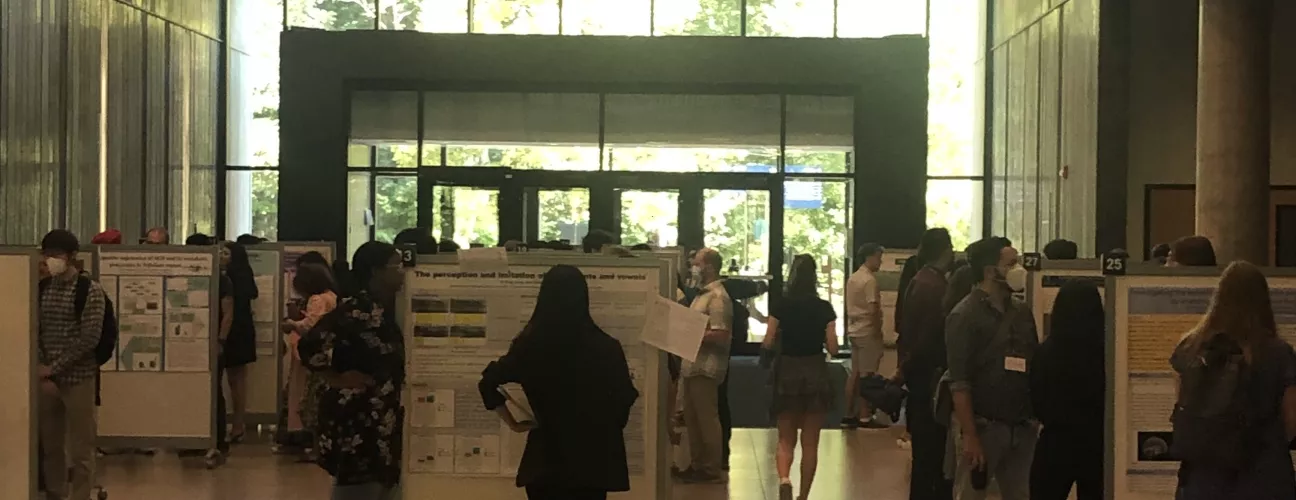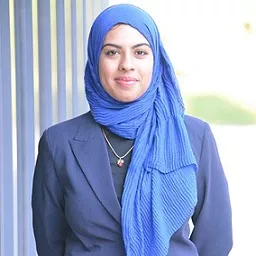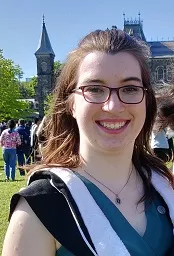
Undergraduate Research Awards
The Centre for Urban Environments (CUE) is a proud supporter of undergraduate research at the University of Toronto Mississauga. Every year, CUE allocates funding to ensure that students can pursue independent and cutting-edge research alongside leading scholars in urban environmental studies. This funding is provided on a competitive basis, with two to five awards provided annually based on academic excellence, research experience and the fit between a student’s proposed project and CUE’s mission to be a leader in research, training, community engagement and policy on urban environments issues.
The total value of each award is $8,000. Students from the natural and social sciences or humanities are encouraged to apply. Successful students will have the opportunity to work full-time under the supervision of a mentor between May 1 to Aug. 31. This work can take place at either the University of Toronto Mississauga or in the field, depending on the requirements of the project.
In summer 2024, the selected students will work on research projects identified by the City of Mississauga.
Interested students are encouraged to review the list of previous winners to learn about the diverse projects CUE has funded in the past.
2024 Winners
Project Title: Community Solutions
Student: Tea Falzata

Supervisor: Prof. Praneeta Mudaliar
Description: Climate change impacts different communities to varying degrees based on a number of geographic and demographic factors. The City of Mississauga, in collaboration with Credit Valley Conservation and the Region of Peel, has identified Sustainable Neighbourhood Action Program (SNAP) in a number of communities in Mississauga. This research will inform future direction of the Climate Change Action Plan, and inform the design of future programs and projects that could benefit from neighbourhood-led initiatives.
Project Title: Emergency Management
Student: Tasmia Jamil

Supervisor: Prof. Kathleen Wilson
Description: In Mississauga, 71% of residential land area has detached homes. Over 80% of the City’s population are in Neighbourhoods, which mainly contain detached homes. The City of Mississauga is expecting the majority of growth to occur in key areas of the City, but 70% of Neighbourhood areas shrank in population between 2011 and 2021. Many of these Neighbourhood areas also have a higher concentration of seniors, who may be over housed. Household sizes are getting smaller, so there are less people living in the average single detached home. This study seeks to answer the question: How might the City promote resilience and better supports for neighbourhood communities that are experiencing population decline, and a higher proportion of seniors, particularly in the event of an emergency? This research will inform future direction and planning for Emergency Management.
Project Title: Groundwater Mapping
Student: Markus Kangur

Supervisor: Prof. Xiaoyong Xu
Description: This study seeks to determine how the City may best determine groundwater levels across Mississauga and identify higher groundwater levels locally or by neighbourhood, that may pose risks to development and/or implementing and managing stormwater infrastructure. It will seek to develop a comprehensive mapping database to inform decision making related to land development, management practices, infrastructure renewal, and could support potential policy changes or changes to City by-laws, standards and criteria. Ultimately, the result may inform the risk of basement water infiltration and location selection for green infrastructure .
Project Title: Urban Agriculture
Student: Audrey Leung

Supervisor: Damian Maddalena
Description: Foodbank Mississauga has doubled the number of clients it serves a month from pre-covid levels, and continues to expect an increased demand. The call to develop urban agriculture was included as an action in the City’s Climate Change Action Plan, which is helping the City mitigate and adapt to a changing climate. The Urban Agriculture Strategy goal is to grow more food locally to ensure everyone has access to healthy foods in their neighbourhoods. This research will look into how the City could support the Urban Agriculture Strategy and greater access to healthy food by leveraging city-owned outdoor spaces. The City of Mississauga joined the Cities Changing Diabetes (CCD) program in 2021 to connect to an international network of municipalities building and sharing strategies to prevent and manage diabetes. Through this membership, the City will access CCD resources, such as case studies from other cities, to inform work on the Mississauga Diabetes Strategy. The City plans to launch a Diabetes Strategy this year, and conducted engagement with the public centered on how to improve healthy living and support access to healthy food. This research will inform future direction of the Urban Agriculture Strategy, and insights may inform future programs or projects.
Project Title: Recreation
Student: Bogdan Lyashenko

Supervisor: Ghazal Fazli
Description: The City of Mississauga has above average diabetes rates compared to the rest of Ontario. Promoting physical activity through targeted and enhanced recreational programs and services is one way the City can support healthy living. Due to a number factors – including technology and demographic changes – the health and recreation needs of the community has drastically changed. As a result the City’s Recreation services and programming must evolve to better encourage healthy active living among the many communities within Mississauga. This research seeks to determine how the City could better support the recreational needs of Cooksville/Downtown that promote health, wellness and physical activity while reflecting shifting demographics in the area, including the growth of multigenerational households. The results of this project will inform new recreational programs and services to help promote increased physical activity and healthy active living.
2023 Winners
Project Title: Repeated local adaptation to urban environments in C. reinhardtii
Student: Jimmy Issa

Supervisor: Prof. Rob Ness
Project Description: Cities act as a strong, multifaceted source of selection on the species that live in them. There is mounting evidence that species have repeatedly evolved adaptive changes to urban environments, resulting in phenotypic divergence between urban and rural populations. However, very little is known about whether urban/rural divergence can lead to speciation. Divergent adaptation between populations accelerates the accumulation of genomic incompatibilities. Therefore, cities have the potential to drive evolution of genomic incompatibilities between urban and rural sites. Urban local adaptation and reproductive isolation might evolve rapidly in microbes with short generation times and large populations.
This project will address these questions using Chlamydomonas reinhardtii, an algal species that is naturally present in soils across both urban and rural environments. C. reinhardtii has the capacity to adapt to common environmental contaminants including cadmium, pesticides, and salt, suggesting that it may do so in nature. Population structure among C. reinhardtii samples that exhibit gene flow suggests that some combination of local adaptation and reproductive isolation may maintain divergent lineages. The main objectives of this project will be to test for repeated local adaptation to urban environments in C. reinhardtii and to test whether any observed adaptation is associated with elevated rates of incompatibilities between isolates.
A series of samples will be collected from urban, agricultural, and rural parkland soils along with microenvironmental measures (soil temperature,moisture levels, sediment type, acidity, colour). The sampling scheme will be guided by heavy metal concentrations in soils, which have been estimated throughout the Greater Toronto Area (GTA), as well as pesticide and other chemical use in agricultural soils. To identify C. reinhardtii in these samples, a high throughput molecular screen for C. reinhardtii in environmental samples that has been recently developed by the Ness lab will be used. To test for local adaptation, a lab-based reciprocal transplant experiment using soil sampled from natural sites will be conducted.
This project will address the role of cities in the evolution and maintenance of adaptive intraspecific diversity and reproductively isolating barriers among lineages.
Project Title: How do cities change sexual selection on females?
Student: Dominik Jaworski

Supervisor: Prof. Rosalind Murray
Project Description: A healthy and sustainable city has to consider not only the health of its human residents, but also the diverse community of life that exists within urban habitats. Recent work has shown that cities are causing patterns of convergent evolution on a global scale . Important studies have demonstrated how natural selection is shaped by the urban landscape. Fundamental to predicting the evolutionary success of urban organisms will be understanding their ability to find and acquire mates . Most of what we do know about urban sexual selection we’ve learned from species with conventional sex roles (i.e. species where males display elaborate secondary sexual traits, and females are choosy about who they mate with. This research, aims to measure the effects of urbanization on selection in a species with sex role reversal and sexual selection is stronger on females than males.
This project will determine the consequences of urbanization on R. longicauda ornament expression, resource availability and sexual selection. A combination of field observations, formal selection analyses, and morphological assessments of ornamentation and nuptial gift quality will be used to determine the fitness consequences of urbanization for both sexes. Flies will be collected from along an urbanization gradient in the Credit River watershed during their flight period in June 2023. Collections will be done during R. longicauda’s site-specific mating swarms.
This project will identify how urban conditions (e.g. water quality, human population density and impervious surface cover) affect sexual selection for metabolically expensive traits (e.g. sexual ornaments), and how cities might differentially shape male and female evolution. This research will broaden the already existing pool or knowledge regarding urbanization and its effect on the evolution of wild species, and will be the first of its kind to demonstrate how stressful city environments might be disproportionately affecting females.
Project Title: Exploring the Effects of Urbanization on the Demography of Habitat
Specialists Using a Landscape Genomics Approach
Student: Zain Nassrullah

Supervisor: Prof. Marc Johnson
Project Description: Urbanization dramatically alters environments and these environmental changes often have cascading effects on the abundance and distribution of species. Some species thrive in response to urban development (e.g., rats, dandelions, pigeons), while other species seldom persist with increased densities of humans and supporting infrastructure (e.g., bears, moose, grouse). Predicting ecological “winners” and “losers” in the face of urban environmental change has eluded clear answers in urban ecology, suggesting novel approaches are needed to understand the features of cities and characteristics of organisms that influence their success in cities. One possible new approach is the use landscape genomics, which combines the techniques of ecology, evolutionary biology, genomics and statistics to examine how urbanization affects long-term changes in population size, and movement of individuals across urban and nonurban landscapes.
This project seeks to answer three questions: 1) How does urbanization affect the change in population size and dispersal (demography) of specialist insects across urban landscapes? 2) Do species with the lowest mobility capacity show the greatest reduction in population size and dispersal across urban landscapes? 3) Are the effects of urbanization greater in large cities? To answer these questions the project will focus on herbivorous insects that specialize on milkweed plants, because habitat/diet specialists are thought to be most susceptible to disturbance. The three species include a range of dispersal capacities, from species that rarely fly like the milkweed stem weevil, to species that have intermediate levels of dispersal such as the red milkweed beetle, to species that are highly dispersive, such as the endangered Monarch butterfly.
Each species from six cities that ranged in population size from the large metropolis of the Toronto area, to midsize cities (London and Kitchener), to smaller cities (Guelph, Brantford, St. Catharines) was sampled. Their DNA was extracted, and genomic libraries were prepared and sequenced at depth. Analysis will be done to estimate how genetic diversity within populations and genetic divergence between populations varies within and between urban and rural environments. Population demographic coalescent modeling will be done to determine how population sizes have changed through time, and how urban development has influenced the movement of individuals between urban and rural locations and among cities.
This project represents a novel interdisciplinary approach to understanding how urbanization affect the ecology and evolution species, and ultimately to predicting how human activity influences the maintenance and loss of biodiversity.
Project Title: Ecosystem metabolism and nutrient cycling along a concrete urban stream
Student: Gabriel Philippe

Supervisor: Prof. Timothy Duval
Project Description: Historically, urban design’s approach to dealing with surface running water was to remove it from the built environment as quickly as possible. To this end, pre-1990’s urban development involved construction of concrete streams that were specifically designed as rapid stormwater effluent channels. Stream channels were straightened, and the concrete streambed meant that stream-soil nutrient and mineral exchange dynamics were absent. As such, these urban stream designs have been deemed to express very little to no ecosystem functioning, and have therefore been subject to restoration efforts in recent years to better conform to natural stream behavior. However, sediment has been found to accumulate at points along these concrete streams, trapping organic matter, which could allow hotspots of increased ecosystem functioning and nutrient cycling within these ecologically unviable designs. The mobility and metabolic activity of these mounds of accumulated sediments remain largely unknown. The aim of this project would therefore be to quantify the biogeochemical activity, ecosystem services, and formation / mobilization of these organic sediment accumulates to better understand their ecological importance in these largely dead environments.
The research project would focus on two main components: continuous measurement of dissolved oxygen (DO) for calculation of stream ecosystem metabolism, and weekly tracking of the sediment-organic matter accumulations with sampling for water quality variables. A 900 m reach of a concrete stream located 12 km from campus here in Mississauga will be examined.
Project Title: Automated delineating urban land use land cover change using high-resolution images
Student: Carolyne Qiang

Supervisor: Prof. Yuhong He
Project Description: Swift and drastic urbanization has induced a quick shift in land use and land cover (LULC) characteristics of cities globally. An accurate and precise representation of the landscape’s spatiotemporal changes provides information on local environmental change, facilitates long-term sustainable urban development applications, and aids future restoration processes. Traditionally, remote sensing approaches that use low to medium-resolution (30 – 250 m) satellite sensors to detect surface change are cost-effective. However, understanding the mechanics behind city expansion is limited due to the lack of spatially comprehensive urban LULC data at high resolution. With the recent improvement of image acquisition platforms, high resolution (< 2m) optical imaging satellites such as the WorldView series provide more means toward mapping and differentiation of subtle and spectrally similar ground features.
This research aims to incorporate high-resolution WorldView2- and WorldView-3 images with advanced image classifiers for high spatiotemporal automated LULC mapping in a heterogeneous urban landscape. The primary study area will be the TRCA watersheds in Ontario. This area comprises heterogeneous LULC features such as agricultural, urban, meadow, forest, and wetland. Drastic urbanization has been seen over the past decade, and the reduction of natural land covers has been noted.
2022 Winners
Project Title: The effects of urban stressors, road salt and heat, on mosquito-vectored disease transmission probability
Student: Sherry Du

Supervisor: Prof. Rosalind Murray
Project Description: De-icing road salts are important for maintaining transportation on roads and walkways in cold climates. Recently, road salts have emerged as a persistent year-round contaminant in Canadian freshwater environments. Salt pollution frequently disrupts ecological communities through species decline and loss. However, for more salt-tolerant species, like mosquitoes, these opportunistic disruptions can decrease predation and competition pressure and allow them to thrive. Importantly, increased mosquito populations in urban areas with high human density have implications for transmission of vector-borne human disease. A potential mitigation strategy is sexual dimorphism: female and male mosquitoes exhibit differences in behaviour, physiology, and/or appearance at various life stages. Female mosquitoes require a blood meal to develop their eggs, while males consume plants as their only adult food source. Because of this difference, adult females are directly dangerous to humans because they can transmit deadly diseases when obtaining their blood meals. Patterns of male-biased adult emergence have been observed across many mosquito species. One hypothesis for this skewed sex ratio is that larger female mosquitoes spend more time as aquatic larvae than smaller males and may be more susceptible to aquatic stressors during this prolonged juvenile period. Additionally, because larval body size can carry over to affect adult size, heightened temperatures (caused by the Urban Heat Island effect) may reduce the body size of adult females. This may further decrease the likelihood of disease transmission as smaller females tend to feed less frequently. This research will investigate the sex-specific impacts of heat and road salt on emerging mosquitoes. By understanding the mechanisms of these stressors influencing mosquito sexual dimorphism, we will be able to target disease-carrying female mosquitoes in our human disease-control efforts in Canadian cities. Ultimately, this research will inform public health and urban planning agencies on preventative strategies against mosquito pests and their potentially deadly human diseases.
Project Title: Effect of Urbanization on Chlamydomonas algae
Student: Scott Ford

Supervisor: Prof. Rob Ness
Project Description: The majority of humans now live in cities and this incredible and rapid urbanization has transformed landscapes across the globe. These newly urbanized environments represent a major shift from the preexisting environments, to the extent that cities are more similar to one another than they are to their surrounding landscape. These new and replicated urban environments are changing both the ecology and evolution of the species that live in cities. What little we know about how urbanization has affected natural microbial communities suggests that they lose biodiversity and converge in complexity. These results suggest the free living microbial communities that underpin many ecosystems are likely heavily impacted by changes to the urban environments. Combined with microbes’ capacity for rapid dispersal and evolution, it is reasonable to predict that cities will drive both the composition and evolution of microbial populations. This project will investigate the following questions: (1) Has urbanization altered the species composition of Chlamydomonas algae and (2) Are urban populations of the model C. reinhardtii less genetically diverse and isolated than those found in surrounding habitats.The continued persistence of urban ecosystems is critical to both the function of cities and to the quality of life of their citizens. This project seeks to gather foundational knowledge at one of the most important but underrepresented scales in biology and will be a basis for further research.
Project Title: Comparing Canadian Municipal Urban Forest Management Plans
Student: Jackson Jung

Supervisor: Prof. Tenley Conway
Project Description: Urban forests have the potential to provide an array of ecosystem services that support healthy communities and people. As a result, many Canadian municipalities have adopted urban forest management plans (UFMPs) to support long-term strategic management of urban trees. A 2013 analysis of these plans compared the 14 existing plans better understand the direction of urban forestry and shortcomings of current efforts). This project will use a content analysis of UFMPs to investigate their visions, objectives, and actions to better understand trends and patterns in municipal urban forest management foci and strategies. The overall objective of this research is to examine all of the plans adopted by the 100 most populous municipalities in Canada. The content of plans adopted at different points in time will be compared to determine if there are shifts in management foci and/or if the shortcoming associated with older plans have been addressed in the more recently adopted UFMPs. Plan content by the municipalities’ location, will also be compared considering differences within and across provinces to see if there is evidence of idea sharing amongst nearby municipalities, and by ecozone, to identify ecologically oriented location-specific strategies (e.g., do municipalities in the Prairies have different visions and objectives than those located in the Pacific Maritime or Mixedwood Plains Ecozone).
Project Title: Plant evolution in response to urbanization
Student: Isabella Vessio

Supervisor: Prof. Marc Johnson
Project Description:With a rapidly increasing global population, the expansion of land use for the development of cities has led to the worldwide phenomenon known as urbanization. Urban areas around the globe have resulted in increased human-ecosystem interactions, influencing both biotic and abiotic conditions of environments. Populations within communities are forced out of the city into rural areas or pressured by natural selection to adapt to the rapidly changing environment, leading to numerous changes in the patterns of biodiversity, species abundance, and phenotypic traits. The Global Urban Evolution Project (GLUE) is the first initiative that assesses environmental and evolutionary change in response to urbanization on a global scale. The GLUE project is a global collaborative effort in which researchers from cities around the world will collect data to assess whether a single model plant, white clover (Trifolium repens), is adapting to urban environments. As part of GLUE, this project will contribute to answering two questions: (1) Is parallel evolution caused globally by urbanization? (2) What is the role of herbivores in driving the adaption of plants to urban environments? These results will be important for developing strategies to preserve biodiversity and ecosystems services as Earth becomes increasingly urbanized.
Project Title: Investigation of Urban Environmental Effects on Type-2 Diabetes: A Case Study in Toronto
Student: Hao Xuan (Peter) Ge

Supervisor: Prof. Jue Wang
Project Description: The rising number of diabetes cases worldwide is emerging as one of the most extensive global health care emergencies. Taking Canada as an example, an estimated 3.4 million (9.3%) Canadians were diagnosed with diabetes in 2015. The senior population is at more risk of developing type-2 diabetes, the type accounting for 90% of the total cases. However, there has been an increasing trend among young adults recently due to physical inactivity and poor diet. Diabetes also causes the highest number of deaths among non-communicable diseases. Moreover, urbanization decreases physical activity and changes dietary habits increasing the prevalence of type-2 diabetes. Therefore, it is essential to prevent and reduce the risk of diabetes by studying its relationships with urban environments and socioeconomic. The objective of this research will investigate urban environmental effects on type-2 diabetes and to what extent the effects may vary by age groups (i.e., young and senior) at the neighborhood level in Toronto. The findings from this study would support health care systems to design better community-based intervention programs and provide beneficial suggestions to control and reduce the increasing rate of diabetes in Toronto. The research findings will be shared in the ArcGIS community through story maps and presented at the next annual meeting hosted by the American Association of Geographers.
2021 Winners
Project Title: Illuminating the Role of Sunlight as a Prospective Driver of Indoor Photochemistry

Student: Lauren Ead
Supervisor: Prof. Matthew Adams
Project Description: Despite traditional beliefs that indoor systems are mostly devoid of high energy ultraviolet (UV) photons, recent works show that indoor irradiance of UV light (340-400nm) can reach one-third of outdoor levels in direct sunlight. This threshold of UV light (340-400nm) operates within the photolysis threshold (≤ 398nm) for nitrogen dioxide (NO2), where the formation of ozone (O3) occurs within our troposphere. Recent studies theorize that NO2 photolysis may be an important source of O3 to the indoor environment, nonetheless, indoor oxidation processes and their estimated reaction products remain poorly characterized. The potential for sunlight to elevate O3 levels within the indoor atmosphere is of great concern amid the ongoing Coronavirus-2019 pandemic, as short-term elevated exposure to O3 can impair immune resistance to viral respiratory infections, including past human coronaviruses. The objective of this research is to assess the impact of sunlight on the photochemical formation of O3 indoors and how this varies over space and time. To evaluate this, the wavelength of incoming solar light over different timescales will be characterized using a spectral irradiance meter while simultaneously assessing changes to indoor O3 and NO2 levels using passive air samplers. These measurements will be paired with continuous monitoring of indoor and outdoor gas-phase chemicals that influence the formation and elimination of O3.
Project Title: The sources and quantity of deposited trace metals on roadside vegetation
Student: Simran Persaud

Supervisor: Prof. Matthew Adams
Project Description: The surface adherence of particulates varies by vegetation species and exposure to rainfall. Location is a factor in deposition rates as well, measurements located closer to major transportation sources were found to have higher concentrations. The toxicity of transportation related pollutants can pose a risk to the survivability of vegetation. For example, if particulate matter is accumulated on vegetation, it can impede the vital function of photosynthesis .The biomonitoring properties of plants are a critical feature that can help identify trace metals as they collect air particulates that reside on their leaves. This collection of pollutants can be analyzed to determine its source's origin. Vegetation samples will be collected from near-road locations. Each sample plot will be characterized by its species, distance to the road, and vehicle counts. Sample times will be characterized by amount of rainfall within the previous week and previous day. Variation in species diversity will be investigated in the select region to determine the difference in species type and their accumulation of particulates. A trace metal analysis will be conducted to quantify concentrations on the leaf and provide evidence to suggest the sources of the deposited particulates. Samples will be collected both before and after rain fall events to investigate the effect of precipitation on the accumulated pollutants. Once the selected leaf samples have been collected, they will go through an acid digestion and microwave heating in preparation for an ICP mass spectrometry analysis. This analysis will produce a chemical breakdown in which the origin of the different particulates can be identified and further investigated.
Project Title: Actions to Mitigate Emissions from Hong Kong’s Aviation Sector
Student: Nikki Wong

Supervisor: Prof. Laurel Besco
Project Description: Emissions from the aviation sector are a serious global challenge to regulate due to its international nature and limitations in current technologies. For these reasons, sufficient mitigation strategies are lacking. Current attribution of aviation emissions to countries are from domestic flights while emission-intensive international flights are not the responsibility of any particular country. With aviation emissions excluded in the UNFCCC, it does not provide strong incentives for countries to mitigate these emissions. As the demand for air travel is anticipated to grow post-pandemic, it is important for aviation emissions to be managed when global aviation currently accounts for >2% of anthropogenic emissions (IATA, 2020).
Hong Kong (HK) is one of the busiest and most efficient international ports in the world, ranking first in air cargo traffic since 2010. Within the past two decades, HK air traffic and its emissions have doubled and contribute to most of the aviation emissions in the Greater Bay Area of China. To address this issue, this research will examine HK’s travel and aviation growth projections, and review new aviation infrastructure plans, aviation emission related-scientific research, and any existing regulatory actions in mitigating aviation emissions. This project also seeks to provide feasible options in devising more efficient reduction strategies for aviation emissions, that bridge the gap between science and law and policy. The research consist of two parts: (1) comprehensive literature review: done remotely (2) Key informant and expert interviews.
Project Title: Residents' attitudes towards, knowledge about, and opinions on coyotes in their neighbourhood.

Student: Fatima Tasabehji
Supervisor: Christoph Richter
Project Description: Working with Vaughan Animal Services this project seeks to develop a survey that would investigate residents' attitudes towards, knowledge about, and opinions on coyotes in their neighbourhood. It also include questions relating to the residents’encounters with coyotes and their expectations as to how coyotes should be managed in their area.
Project Title: Sustainability and the Scared
Student: Chloe Kapanen

Supervisor: Stephen Scharper
Project Description: Often discourses surrounding sustainability focus on the environmental impacts of destructive behaviors. While this is critical to the progress of environmental justice, “Sustainability and the Sacred” seeks to expand the notions of sustainability to include not only the problems with environmentally destructive behaviors but also the underlying worldviews that inform such practices. To ensure that sustainability efforts do not translate to further developmental paradigms focused on profitability, sustainable solutions must address the root problem which has led us to this point: worldviews that have forgotten the sacred value in the environment, in other species, and our own communities. In response, “Sustainability and the Sacred” offers a holistic view of sustainability as not only encompassing ecological wellbeing but also the wellbeing of all species, including but not limited to, humans. This research examines various worldviews which connect the sacred to sustainability. From various religions such as Judaism, Hinduism, Christianity, and Buddhism which have reinterpreted sacred texts through an ecological lens; to Eco-Feminist theory, and Indigenous Worldviews, the project amplifies critical voices of those deconstructing the class-based, race-based, and gender-based hierarchies laden within environmental degradation. Incorporating case studies, ethnographies, and the personal experiences of researchers and environmentalists, the research focuses on practical applications of the sacred in sustainability. From cities and urban environments to forests, rivers, and oceans, at the heart of this project is an exploration of a question of what truly matters to us and why. What values do our current practices reflect and what do we want our values to reflect? Most importantly, how we rediscover and reconnect to the Sacred of the world and all living things within it to ensure a sustainable future for all living things, grounded in spiritual values and connection?
Previous Winners
2020
Project Title: The case for a waste-diversion offset scheme: Application to Markham’s and the NACTR’s textile recycling program.

Student: Carina Suleiman
Supervisor: Prof. Barbara Murck
Project Description: Within waste management, the issue of textile waste presents a significant challenge, accounting for five to seven per cent of waste in landfills. Addressing this issue is a prominent proposal for achieving environmental sustainability. In Canada, the City of Markham became the first North American municipality to ban all textile waste from landfills. In this research Carina will seek to understand how collaboration of municipal and charitable organizations can help solve the environmental challenge of textile waste management. The project seeks to develop a carbon offset scheme that will include data from the National Association of Charitable Textile Recycling (NACTR, 2020). Through this scheme, this project expects to aid industries wishing to offset their emissions in collaboration with the NACTR, whose aim it is to nationally increase textile waste diversion, and Canadian municipalities who want to reduce carbon emissions.

Project Title: Novel Molecular Mechanisms in Tree Resistance to Urban Stresses
Student: Ahmed Hanif
Supervisor: Prof. Katharina Braeutigam
Project Description: Urbanization can have substantial effects on our natural environment including increased levels of air pollutants, changes in water quality and altered levels of soil pH, compaction and toxin content. It is thus critical to understand the effects of such anthropogenic stressors on living organisms at the mechanistic level. Urban trees likely experience a number of stresses over their long life span. Nevertheless, much remains to be learned about tree responses to stressors typical to urbanized environments. Ahmed will look at tree response to urban stressors such as road salt exposure, increased soil pH and soil compaction. This work will be conducted in native deciduous trees of the genus Populus. The results from this research will provide the opportunity to contribute to our understanding of longterm stress exposure in trees, molecular coping mechanisms (and their limits) and yield critical information applicable to urban forest health.
2019
Project Title: Managing Stormwater Runoff in Urban Catchments
Student: Zarin Mom

Supervisor: Prof. Xiaoyong Xu
Project Description: Due to the impacts of climate change, the frequency of extreme meteorological and hydrological events is expected to rise. The high levels of stormwater that often accompany these events can cause adverse environmental effects, such as residential damage, degrading water quality and the destruction of creek channels. Zarin Mom’s project reviewed the impact of various controls (such as grass swale and ditches) in preparing for, and managing, this storm water runoff. Integrating both storm-water management modelling and remote sensing imagery, Zarin’s project provided an innovative method for diagnosing and troubleshooting drainage issues in municipalities around the world. Zarin was able to leverage the unique technologies available at the Centre for Urban Environments to create an innovative evaluative approach. Her findings were presented at Smarti Gras, UTMs summer research day for undergraduate students.
Project Title: Residential Yards and Green Infrastructure

Student: Shefaly Gunjal
Faculty Supervisor: Prof. Tenley Conway
Project Description: For many of us, a back yard can be a place of relaxation, socialization and beauty. But it is also part of a larger ecosystem. Trees, gardens, green roofs and other vegetation can contribute to storm water attenuation, microclimate regulation, air pollution reduction and physical and physiological well-being. Understanding residents’ perspectives when it comes to their yards, and the differences in perspectives across cities, is therefore useful in understanding the development of Green Infrastructure. Alongside Tenley Conway in the Department of Geography, Shefaly Gunjal’s project explored this question through the surveying of residents in Toronto, Philadelphia and Malmo. From these surveys, Shefaly was then able to formulate tangible policy recommendations for municipal governments of all sizes. Their findings were presented at Smarti Gras, UTMs summer research day for undergraduate students.
Project Title: Precipitation Trends in the GTHA

Student: Kaitlin McNeil
Faculty Supervisor: Prof. Kent Moore
Project Description: Climate change and rapid urbanization have combined to increase the average temperature of Toronto and its surrounding area. Understanding the implications of these changes for weather and precipitation is important, as an increase in precipitation in the GHTA could lead to more frequent flooding and infrastructural damage. Using data from as early as 1840, collected from archival resources available at the University of Toronto, Kaitlin McNeil explores potential correlations in temperature and precipitation changes, finding that changes in both appear more erratic after 1960 compared to any time previously.
Her findings were presented at Smarti Gras, UTMs summer research day for undergraduate students. Building on this project, Kaitlin is currently exploring the relationship between these urban trends and potential changes measured in rural areas across Ontario.
Project Title: Urban Greenspaces and Bluespaces: How cities can use them to encourage community building

Student: Juan Sebastian Alvarez Salinas
Supervisor: Prof. Laurel Besco
Project Description: Green infrastructure is a well-defined term in the environmental studies literature, yet 'greenspaces' lack an accepted definition across disciplines. Likewise, 'bluespaces' is a recent term focused on identifying eco-water features to ensure policymakers and researchers are considering water resources. This project cultivated definitions of these emerging terms and examined their relationship to ecosystem health, economic growth, public health and recreation. From this, Juan developed four critical considerations for integrating green and blue spaces into community development: (1) maximizing space efficacy and value to the local community; (2) the role of residents in blue and greenspace intervention; (3) the role of these spaces in a sense of security, social cohesion and place of attachment; and (4) their role in promoting social interactions within a community. His findings were presented at Smarti Gras, UTMs summer research day for undergraduate students.
